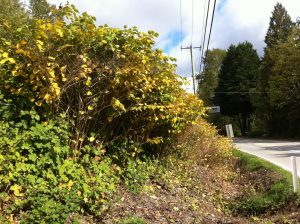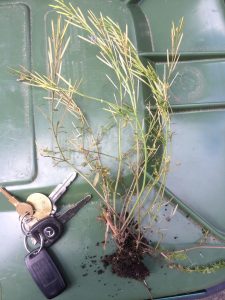Japanese knotweed is a nasty invasive perennial plant which destroys habitats especially around water bodies. As soon as I found a patch at a far corner of my site, I was on high alert. The invader probably benefitted from soil disturbances as condominium construction happened on both sites.
Headache
This is bound to be huge headache because our site is on the right and nobody is maintaining the area on the left. Since knotweed spreads by roots this will be a constant fight. Knotweed roots can extend for 20m from the parent plant and 3m deep. Definitely call or click before you dig. I hope the landscape maintenance company next door takes action soon.
We didn’t have time to dig but we flush cut the hollow bamboo-like canes as close to the ground as possible. Some people are tempted to pour illegal substances on the stumps under cover of darkness. I know many municipalities use heavy chemicals that would be illegal for residents to apply. That’s how desperate it has become.

City of Coquitlam, BC. This is a common roadside problem. The city sprayed this patch to keep it in check and off the roadway.
Knotweed details
The flowers on knotweed are actually attractive. They are small, white and grow in showy, plume-like, branched clusters along the plant stem and leaf joints. How can you make sure you’re dealing with knotweed in the absence of flowers? Look for the zigzag pattern in which leaves are arranged along the plant stems.
Knotweed isn’t the only bad boy invading our landscapes. There is a long list of others. Learn to recognize them and try to plant sound alternatives. Visit the Invasive Species Council of BC. They also have volunteer opportunities. But education is key.
Learning to recognize weeds is actually an important skill. New landscapers struggle in this department because machine use comes first. But once they do finesse-type work they need to recognize unwanted weeds from good plants. This takes time just like plant identification skills. Fortunately, there are only so many key weeds in our landscapes.











